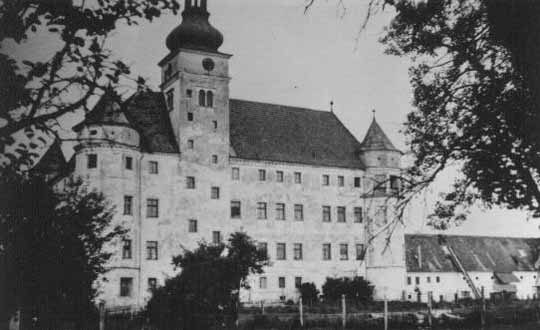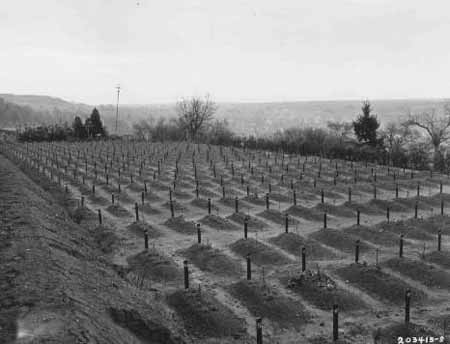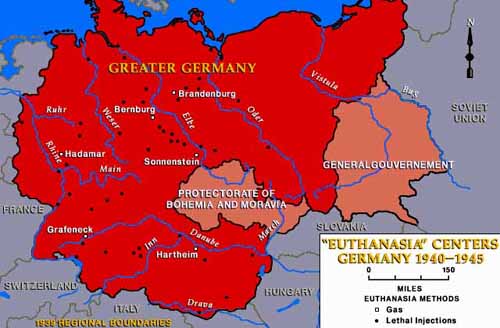Background & Overview
In the fall of 1939 the German government
established, under the Reich Chancellery, the Euthanasie Programme under the direction of Philip Bouhler and Dr. Karl Brandt. The
headquarters of the operation were at Tiergartenstrasse 4, Berlin and
the code name for the program was derived from that address—T-4.
The choice of terminology for the program is
consistent with the Nazis' penchant for euphemism. Euthanasia
typically means "mercy killing" and in the 1990's in the
United States and other western nations, it is synonymous with
"physician-assisted suicide." The kind of killing carried
out through the T-4 program bears little resemblance to contemporary
concepts of euthanasia.
 Hartheim Castle, a "euthanasia"
killing center where the physically and mentally disabled were
killed by gassing and lethal injection. Hartheim, Austria (USHMM
Photo)
Hartheim Castle, a "euthanasia"
killing center where the physically and mentally disabled were
killed by gassing and lethal injection. Hartheim, Austria (USHMM
Photo) |
Hitler's rise to power produced a completely new set of definitions. Guided by
the over-riding principles of racial hygiene, racial purity, and
national health, the Nazi regime seems fairly consistently committed
to the removal of those unfit to live and produce inferior offspring.
In 1935, the Nuremberg
Laws provided for the forced sterilization of the unfit. Not only
did Hitler have in mind such "inferior races" as Jews and Gypsies,
he also included unfit Aryans—the mentally defective, severely
handicapped, the incurably insane and the incurably sick.
To implement the euthanasia program, special
carbon-monoxide chambers were constructed. According to Milton
Meltzer:
Between December 1939 and August 1941, about
50,000 to 60,000 Germans—children and adults—were secretly
killed by lethal injections or in gassing installations designed to
look like shower stalls. It was a foretast of Auschwitz. The
victims were taken from the medical institution and put to
death.... (Never to Forget, New York:HarperCollins,
1976:131.)
Robert J. Lifton makes the following assessment:
Of the number of people killed in the T4 and the
14f13 projects, the following statistics are usually given: adult
mental patients from institutions, 80,000 to 100,000; children in
institutions, 5,000; special action against Jews in institutions,
1,000; concentration camp inmates transported to killing centers
(14f13), 20,000 (Klee estimated that at the end of 1941, some
93,521 `beds' had been emptied for other uses [70,000 patients
gassed, plus over 20,000 dead through starvation and medication] -
in other words approximately one-third of the places for the
mentally ill.) But these figures may well be too low; twice these
numbers of people may have perished. The fact is that we do not
know and shall probably never know. Elements of deception, imposed
chaos, and the destruction of many records make anything like an
accurate estimate impossible.
The same is true concerning the total number of
people murdered at specific killing centers. Hartheim victims of
both ordinary `euthanasia' and 14f13 are variously estimated from
20,000 (by Dr. Georg Renno, Lonauer's successor as director), to
400,000 (by Franz Ziereis, the former commandant of Mauthausen, on
his deathbed); 30,000 is believed to be the best estimate. While
these figures may seem unimpressive when placed next to the
millions killed in the Final Solution, they represent the murder of
shockingly large numbers of people—all in places characterized as
hospitals." (The Nazi Doctors: Medical Killing and the
Psychology of Genocide. London: Papermac, 1986 (Reprinted 1990)
p. 142).
Hans-Heinrich Wilhelm informs us:
The first large-scale euthanasia action seems to
have taken place in Pomerania and eastern Prussia shortly after the
Polish campaign. During 1940, four euthanasia institutions went
into operation: Grafeneck, in January, Brandenburg, in February,
Hartheim, in May and Sonnenstein, in June. In the first half of the
year, 8,765 persons were gassed in these four institutions,
three-quarters of them in May and June, a time when world attention
was focused on the Battle of France. By the end of 1940, a total of
26,459 patients had been put to death, and in the first eight
months of 1941, an additional 35,049 were "disinfected."
These were the figures given by the accounting section of T4's head
office. ("The Euthanasia Program," in The Encyclopedia
of the Holocaust, Vol II, pp.452-454)
Robert E. Conot makes the important connection
between the euthanasia program and the Final
Solution:
"Concurrent with the start-up of the
euthanasia exterminations, Hitler authorized Himmler to establish a Race and Resettlement Office under the aegis of the
SS. It was the Race and Resettlement Office that was to be
responsible for the `racial' purification of the Reich and the
establishment of a Nordic empire. On October 17, 1939, Keitel
summoned the victorious Wehrmacht generals for a lecture from the
Fu"hrer, who ranted: `The increased severity of the racial
struggle permits of no legal restrictions. Jews, Poles, and similar
trash are to be cleared from the old and new Reich territories.'
Eight million Poles and 800,000 Jews were to be transported from
the annexed portion of Poland into the government-general, and
replaced by ethnic Germans repatriated from the Baltic lands, the
Balkans, Russia, and the Italian Tyrol—even though, in large
part, these Germans had emigrated generations before.
 Cemetery at Hadamar where victims of “euthanasia”
at the Hadamar “euthanasia” killing center were buried. This
photograph was taken toward the end of the war. Hadamar, April
1945 (NARA Photo)
Cemetery at Hadamar where victims of “euthanasia”
at the Hadamar “euthanasia” killing center were buried. This
photograph was taken toward the end of the war. Hadamar, April
1945 (NARA Photo) |
To `render harmless' the Polish intelligensia,
political and religious leaders, Jews, and anyone else who might,
theoretically, rally an opposition, Heydrich established SS Einsatzgruppen (action groups). The Einsatzgruppen rampaged over the land,
terrorizing and killing. Selections for execution were haphazard.
Sometimes the commandos erred and included ethnic Germans whom they
mistook for Jews. Shootings were carried out publicly to heighten
the climate of fear. A Werhmacht intelligence officer reported:
`Arrests were almost always accompanied by looting. Evacuations
were carried out and blocks of houses were cleared at random, the
inhabitants loaded into lorries at night, then taken to concentration
camps. Actions against the Jews were carried out with the most
serious excesses. A number of Jews were driven into a synagogue,
where they had to crawl, singing, between the benches. Forced to
take down their trousers, they were continuously whipped by the SS
men on their bare behinds. A Jew who out of fright dirtied himself
was forced to smear the excrement onto the faces of the other Jews.
`After about fifty Jews, who had been used
during the day to repair a bridge, finished their work in the
evening, two SS men drove them into a synagogue and shot them all
without any reason.' (Judgement At Nuremberg, New York:
Harper & Row, 1983, pp 211-212.
The euthanasia program proved to be a valuable
precursor to the atrocities which were to come in connection with the
"Final Solution." SS Major Christian Wirth was transferred
from his duties at a euthanasia center to take over the supervision
of Chelmno, the first of six extermination
camps in Poland to become operational. His expertise in mass
extermination seems to have been a major consideration. Wirth later
served at Belzec, Treblinka and Sobibor.
In 1940, Franz Stangl was transferred from one of the euthanasia
centers to Sobibor extermination camp
where he served as camp commander. He performed so well there that he
was transferred in the summer of 1942 to Treblinka [Many years later,
in 1970, Stangl was extradited from Brazil to West Germany to stand
trial. He was found guilty of joint responsibility for the murder of
900,000 Jews]. After the Wannsee
Conference in 1942, the staff of Euthanasia Program was
transferred to Operation
Reinhard.
Sources:The
Holocaust\Shoah Page
|


